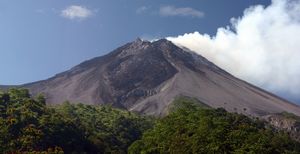Thursday, October 19, 2006
Merapi Mountain
 The most active Vulcanoe in Indonesia. Statically it would erupted in every 2~5 years. This mountain favor by local and foreign tourist. It take 5 hours to climb and 3 hours to return. Peoples prefer the north slope thru Selo. Other from South west route thru Kinah rejo. Route from southwest is possible but dangerous as the lava flow path is here. It is really an active vulcanoe; at the clear night we can see hot red molten lava.
The most active Vulcanoe in Indonesia. Statically it would erupted in every 2~5 years. This mountain favor by local and foreign tourist. It take 5 hours to climb and 3 hours to return. Peoples prefer the north slope thru Selo. Other from South west route thru Kinah rejo. Route from southwest is possible but dangerous as the lava flow path is here. It is really an active vulcanoe; at the clear night we can see hot red molten lava.Mount Merapi, Gunung Merapi in Indonesian language, is a conical volcano in Central Java, Indonesia. It is the most active volcano in Indonesia and has erupted regularly since 1548. Its name means Mountain of Fire. It is very close to the city of Yogyakarta, and thousands of people live on the flanks of the volcano, with villages as high as 1700 m above sea level.
Several of its eruptions have caused fatalities. It was erupting from 1992 to 2002, and a particularly large explosion killed 43 people in 1994. It began erupting again in 2006, and scientists believe a large eruption is imminent. In light of the hazards it poses to populated areas, it has been designated a Decade Volcano.
Merapi is the youngest in a group of volcanoes in southern Java. It is situated at a subduction zone, where the Indo-Australian Plate is sliding beneath the Eurasian Plate. It is one of at least 129 active volcanoes in Indonesia, part of the Pacific Ring of Fire - a section of fault lines stretching from the Western Hemisphere through Japan and South East Asia.[1] Stratigraphic analysis reveals that eruptions in the Merapi area began about 400,000 years ago, and from then until about 10,000 years ago, eruptions were typically effusive, and the outflowing lava emitted was basaltic. Since then, eruptions have become more explosive, with viscous andesitic lavas often generating lava domes. Dome collapse has often generated pyroclastic flows, and larger explosions, which have resulted in eruption columns, have also generated pyroclastic flows through column collapse.
wikipedia.org
Subscribe to Comments [Atom]